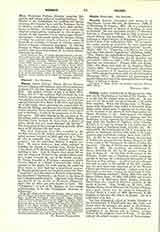

Nisibis, titular Archdiocese of Mesopotamia, situated on the Mygdonius at the foot of Mt. Masius. It is so old that its original name is unknown. In any case it is not the Achad (Accad) of Genesis, x, 10, as has been asserted. When the Greeks came to Mesopotamia with Alexander they called it Antiochia Mygdonia, under which name it appears for the first time on the occasion of the march of Antiochus against the Molon (Polybius, V, 51). Subsequently the subject of constant disputes between the Romans and the Parthians, it was captured by Lucullus after a long siege from the brother of Tigranes (Dion Cassius, XXXV, 6, 7); and by Trajan in 115, which won for him the name of Parthicus (ibid., LXVIII, 23). Recaptured by the Osrhoenians in 194, it was again conquered by Septimius Severus who made it his headquarters and established a colony there (ibid., LXXV, 23). In 297, by the treaty with Narses, the province of Nisibis was acquired by the Roman Empire; in 363 it was ceded to the Persians on the defeat of Julian the Apostate. The See of Nisibis was founded in 300 by Babu (d. 309). His successor, the celebrated St. James, defended the city by his prayers during the siege of Sapor II. At the time of its cession to the Persians, Nisibis was a Christian center important enough to become the ecclesiastical metropolis of the Province of Beit-Arbaye. In 410 it had six suffragan sees and as early as the middle of the fifth century was the most important episcopal see of the Persian Church after Seleucia-Ctesiphon. A great many of its Nestorian or Jacobite titulars are mentioned in Chabot (“Synodicon orientale”, Paris, 1902, 678) and Le Quien (Oriens christ., II, 995, 1195-1204) and several of them, e.g. Barsumas, Osee, Narses, Jesusyab, Ebed-Jesus, etc., acquired deserved celebrity in the world of letters. Near Nisibis on June 25, 1839, Ibrahim Pasha, son of Mehemet Ali, Viceroy of Egypt, won a great victory over the troops of Mahmud II. Today Nezib is a town of 3000 inhabitants in the sandjak of Orfa and the vilayet of Aleppo. Its oil is considered very fine.
The first theological school of Nisibis, founded at the introduction of Christianity into the town, was closed when the province was ceded to the Persians, great persecutors of Christianity. St. Ephraem reestablished it on Roman soil at Edessa, whither flocked all the studious youth of Persia. In the fifth century the school became a center of Nestorianism. Archbishop Cyrus in 489 closed it and expelled masters and pupils, who withdrew to Nisibis. They were welcomed by Barsumas, a former pupil of Edessa. The school was at once reopened at Nisibis under the direction of Narses, called the harp of the Holy Ghost. The latter dictated the statutes of the new school. Those which have been discovered and published belong to Osee, the successor of Barsumas in the See of Nisibis, and bear the date 496; they must be substantially the same as those of 489. In 590 they were again modified. The school, a sort of Catholic university, was established in a monastery and directed by a superior called Rabban, a title also given to the instructors. The administration was confided to a majordomo, who was steward, prefect of discipline, and librarian, but under the supervision of a council. Unlike the Jacobite schools, devoted chiefly to profane studies, the school of Nisibis was above all a school of theology. The two chief masters were the instructors in reading and in the interpretation of Holy Scripture, explained chiefly with the aid of Theodore of Mopsuestia. The course of studies lasted three years and was entirely gratuitous; but the students provided for their own support. During their sojourn at the university, masters and students led a monastic life under somewhat special conditions. The school had a tribunal and enjoyed a civil personality, being able to acquire and possess all sorts of property. Its rich library possessed a most beautiful collection of Nestorian works; from its remains Ebed-Jesus, Metropolitan of Nisibis in the fourteenth century, composed his celebrated catalogue of ecclesiastical writers. The disorders and dissensions, which arose in the sixth century in the school of Nisibis, favored the development of its rivals, especially that of Seleucia; however, it did not really begin to decline until after the foundation of the School of Bagdad (832). Among its literary celebrities mention should be made of its founder Narses; Abraham, his nephew and successor; Abraham of Kashgar, the restorer of monastic life; John; Babai the Elder; three catholicoi named Jesusyab.
S. VAILHE

